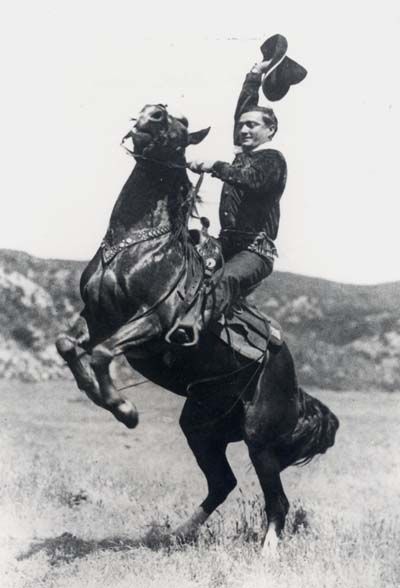
Today’s blog entry was written by Gary Syck
Despite what you see in movies and on TV, rearing is an unsafe maneuver and should be avoided at all costs. While you can do things to prevent rearing, your horse may have other ideas. In these cases, a quick and correct reaction is important to reduce the chance of injury to you and your horse.
The best way to stay safe in a rear is to prevent it from happening in the first place. A horse’s first reaction to danger is to run away. When that is not possible, rearing puts them in a defensive posture. Stunt riders use this natural behavior to get those exciting rears in movies. They give an urgent command to move, signaling danger, then they block movement with the reins. The nervous horse can’t move forward, so he rears. Avoiding these inputs will avoid the reaction. Keep your legs quiet and your hands soft and your horse will have no reason to rise.
In the wild, horses can use rearing as a way to dislodge a threat on their back. While riding, you are precisely in the spot that a predator would attack to bring a horse down. The only reason the horse lets you up there is that he trusts you to keep him safe. If you are wiggling around up there or making strange noises, the horse may lose that trust and he will do what he can to get you off. You will know that this is the case, because the horse will add bucking to the rear to make it as hard as possible to hang on. A quiet, confident seat tells the horse that you have everything under control and maintains that trust he needs.
You may see your horse rear during free lunging. In most cases, this is simply exuberance and presents no danger. Watch that the horse doesn’t go too high and remains balanced. If the rearing is unstable or aimed at people or horses, you need to calm the horse with your voice. Do not try to move in on a rearing horse. Make sure that any people or other horses leave the area until the situation is under control. Once your horse stops rearing and you can capture him, you should put him on the lunge line to get him used to moving forward correctly. Be very aware of his mood as you move around him, but do not make the situation worse by being tentative. Most horses will calm down when there is someone trustworthy to take charge.
When riding, a rear requires quick action. If you are confident in your ability to do an emergency dismount, this is the time to do it. Once on the ground move away, keeping in mind that after rearing, the horse may buck, so you do not want to be in front or behind. Use your voice to calm the horse and wait until he is settled before approaching. Show your horse that you are his safety zone. The sooner you get him calmed the better, to keep him from bolting into a dangerous situation or getting tangled in his tack.
If you did not dismount right away, your best bet is to ride out the buck. Lean slightly forward to help keep the horse in balance. Do not pull on the reins! Keep your seat firmly in the saddle and wait for the horse to come down. When he does, sit deep, if you have leaned too far forward, he may go right into a buck. Immediately command the horse to go forward. Knowing that he can move forward gives him something to do besides rearing or bucking. Speak calmly to your horse to let him know there is nothing more to fear. Getting back to work will help get both your mind and the horse’s off the recent excitement.
As you ride, take a moment to consider what caused the rear. Perhaps you were out of balance, or you had the reins too tight. Maybe a noise or sudden movement startled the horse. Correct your riding mistakes and help your horse understand the environmental causes to that you don’t have to go through the rear again.
First appeared in Ezine Articles.com
